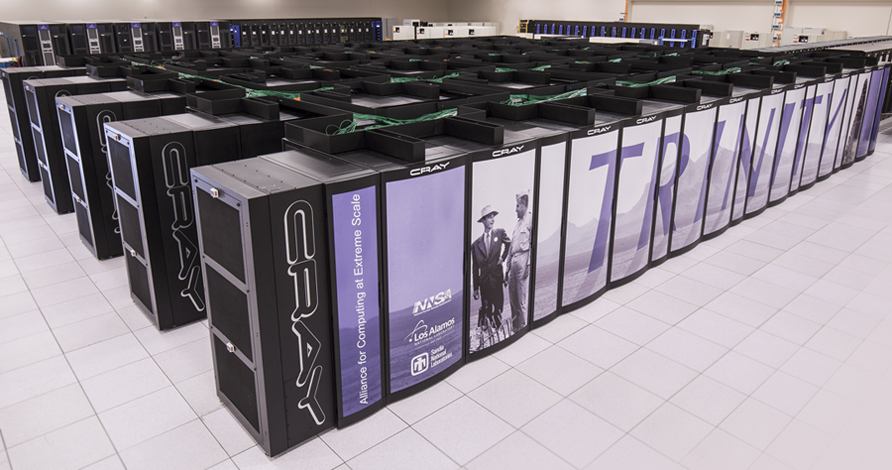In this special guest feature, Jane Glasser writes that Cray is winning new business with its Cray XC Series systems featuring the Intel Xeon Phi processor.

The Trinity Supercomputer at LANL is just one the new Cray XC systems featuring Intel Xeon Phi
They were two companies born about the same time in different neighborhoods. They attacked the same problems using very different approaches. They drove supercomputing forward for 30 years from parallel universes (pun intended).
However, in 2008, after 30 years of competition, Cray and Intel found common ground. Since then, the two supercomputing giants have rapidly increased their collaboration to the benefit of the supercomputing market and customers.
Most recently, Cray has announced win after win for its Cray® XC™ series systems that feature the Intel® Xeon Phi™ processor, code-named Knights Landing and Knights Hill, which offers peak performance of over half-a-petaflop per cabinet—a 2X performance boost over previous generations. Cray is leading the charge toward many-core-CPU systems that boost application performance without the aid of GPUs.
Parallel paths converge
When the first Cray-1 system was installed at Los Alamos National Laboratory in 1976, it boasted a world-record speed of 160 million floating-point operations per second (160 megaflops) and an 8 MB main memory. Early Cray systems pioneered the use of vector processors, which powered supercomputers from the 1970s through the 1990s.
Intel challenged the supercomputer world in the late 1980s by suggesting that superior performance could be attained by replacing expensive vector processors with conventional off-the-shelf microprocessors. While Cray was doing parallel supercomputing with custom vector processors, Intel created its own MPP systems and also worked with leading OEM hardware providers to design MPP systems based on Intel processors.
In 2008, Cray and Intel announced a major partnership: Cray would start using Intel processors in its high-performance computing (HPC) systems. That same year, Cray introduced its first Intel processor-based supercomputer, the Cray CX1.
In 2012, the partnership deepened with Cray’s launch of the Cray XC systems, based on the Intel Xeon® and Intel Xeon Phi processors. “We build systems using the best processors available, and in the early 2010s, it became clear that those were Intel processors,” explains Steve Scott, Senior Vice President and Chief Technology Officer at Cray.
Also in 2012, Cray sold its interconnect hardware IP and development program to Intel, a mind-meld that led to the development of the Intel® Omni-Path Architecture.
Today, Intel consults closely with Cray to design and test its high-end processors and resolve system integration issues. The two companies also have a joint HPC software innovation effort
Champions of Intel® Xeon Phi™ processor
Cray and Intel lately find themselves in many of the same press articles due to Cray’s repeated wins involving the Intel Xeon Phi processor, a foundational element of Intel® Scalable System Framework.
“People think of Cray as a hardware developer, but we’re really a systems company, with more software than hardware engineers,” Scott says. “We have decades of experience building software systems and have brought that experience to bear on integrating the Intel Xeon Phi processor into our systems. The technology alignment is a natural.”
Scott explains that original Cray vector processors used vector architectures that boasted very high memory bandwidths and parallel threads. Many of these same characteristics are in the Intel Xeon Phi processor. “The Xeon Phi processor fits very well into our adaptive supercomputing strategy, which aims to build flexible infrastructure, and apply the right processor for the right job,” Scott says. “We’ve been pleased to see how easy it is to port code to the Xeon Phi processor. Modernizing code for the Xeon Phi processor is a big concern of our customers, and we’re happy to tell them that it requires less effort than we’d expected.”
“Together with industry leaders like Cray, Intel is re-architecting the High Performance Computing ecosystem with the Intel® Scalable System Framework and its transformative elements, like the Xeon Phi Processor Family and Omni-Path Architecture,” said Charles Wuischpard, Vice President and General Manager of Intel’s Scalable Datacenter Solutions Group. “Cray’s integration of our latest technologies into their high performance computing platforms brings users ease of deployment and the computational power necessary to advance their discovery and innovations in science, analytics and machine learning.”
Cray has just started shipping Cray XC series systems based on Intel Xeon Phi processors. Take a look at the breadth of these new installations:
- Trinity, managed and operated by Los Alamos National Laboratory and Sandia National Laboratories under the Alliance for Computing at Extreme Scale (ACES) partnership, is a Cray XC supercomputer that will help the National Nuclear Security Administration provide the U.S. with a safe, secure, and effective nuclear deterrent. It is expected to be the fastest supercomputer in the U.S. and the second or third fastest in the world.
- Cori at the U.S. Department of Energy’s (DoE) National Energy Research Scientific Computing Center (NERSC). NERSC will use its Cray XC supercomputer for diverse research in climate modeling, biology, environmental sciences, combustion, materials science, chemistry, geosciences, astrophysics, and other disciplines. NERSC supports more than 5,000 scientists annually on more than 700 projects.
- Theta and Aurora at the DOE’s Argonne Leadership Computing Facility at Argonne National Laboratory. In 2012, three leading U.S. research facilities formed the Collaboration of Oakridge, Argonne, and Livermore (CORAL), with the mission of acquiring next-generation Leadership Computing systems for DOE. Theta will be the first of the Argonne systems, coming in late 2016, and Aurora the second, delivered in 2018. They are both Intel Xeon Phi processor-based systems, with Theta using the current Intel Xeon Phi processor (formerly known as Knights Landing) and Aurora using the future Intel Xeon Phi processor codename Knights Hill.
- The Academic Center for Computing and Media Studies (ACCMS) at Kyoto University. ACCMS is acquiring a Cray XC40 system, which it says will potentially provide a two-fold application performance improvement for research and development related to the advanced use of information technology infrastructure and information media.
While Cray has a significant footprint in national labs, government agencies, and academia, it also has a growing business in industry. You’ll find Cray supercomputers crunching seismic data in oil and gas companies, performing structural analysis and computational fluid dynamics in manufacturing firms, doing risk analysis for financial services firms, and performing genomics and molecular modeling. And don’t forget about weather forecasting; the majority of the world’s large weather forecasting systems are Cray.
Looking ahead

Steve Scott, SVP & CTO at Cray
Scott says that the next decade will bring significant technology challenges, chiefly in the areas of power conservation and reducing the cost of moving data. “We will need high-performance memory systems that can provide higher bandwidth at lower power,” Scott says. “The on-package memory systems and other innovations in the Intel Xeon Phi processor will play an outsized role in computer architectures and in taking us to Exascale computing in the next decade.”
While Chinese supercomputers are zooming up the “TOP” lists, Scott isn’t perturbed. “Our emphasis on HPC has always been and will remain sustained delivered performance and not ranking high on the TOP-500 list,” Scott says. “What China is doing should be taken seriously, but I don’t think it’s a sign that the U.S. has lost its leadership. We’re focused on building very productive machines.”
Cray is eager to see the results of the National Strategic Computing Initiative (NSCI), a national initiative to ensure that the United States continues to lead in HPC over the coming decades. “We’ve worked for years with the DOE, which has the most boots on the ground in strategic computing,” Scott says. “We’re happy to see an effort toward cross-agency collaboration between all the federal agencies and labs. We’re eager to see these efforts turn into concrete policy and funding.”
As for the future with Intel, Scott says, “We look forward to continuing our partnership with Intel to build ever larger and more capable systems.”




